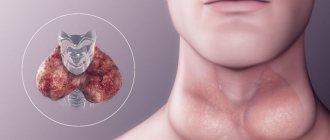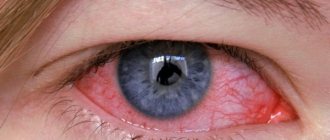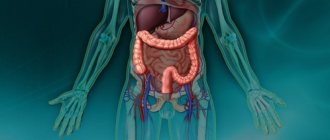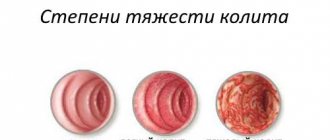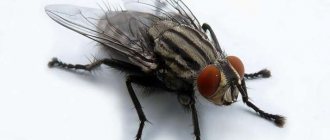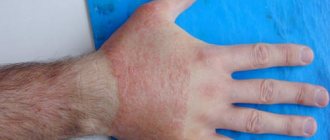Intestinal candidiasis – fungal infection of the mucous membrane of the intestinal wall by fungi, mainly of the genus Candida. Fungi are considered opportunistic pathogens that can be found on the skin and mucous membranes of healthy people. This rule applies mainly to microorganisms of the Candida family, which differ in their aggressiveness and ability to cause disease. The most common are Candida albicans, C. krusei, C. kefyr, C. tropicalis.
In people with normal immunity, fungi exist asymptomatically, without causing harm, and only under certain conditions can they lead to severe inflammation with corresponding symptoms.
Causes
The adult intestine is covered with a mucous membrane, under which there is a layer of glycoprotein (protein associated with oligosaccharides). Glycoprotein is a physiological barrier that prevents the entry of pathogenic microorganisms into deeper layers, as well as into the bloodstream. But each type of fungus has aggressive factors, thanks to which they are able to attach to the epithelium and cause its damage (enzymes - coagulase, phospholipase and others).
The combination of these two points (weakening of the intestinal protective barrier and increasing the level of fungal enzymes due to its active reproduction) can lead to the development of candidal inflammation of the mucosa.
In what case and under what circumstances is it possible to implement these conditions?
Risk factors
For the development of intestinal candidiasis, a persistent decrease in general and local immunity is necessary, which plays the role of protection against opportunistic flora. Below are considered the conditions under which Candida fungi begin to actively multiply and damage the gastrointestinal tract:
- chronic intestinal diseases: colitis, duodenitis, proctosigmoiditis, hemorrhoids, diverticulosis, polyps, Crohn's disease, irritable bowel syndrome, ulcerative colitis and others;
- damage to the mucosa by invasive examinations (colonoscopy, sigmoidoscopy), foreign bodies;
- pregnancy (natural weakening of the immune system, hormonal fluctuations);
- newborn children (immature defense system against fungi);
- patients over 70 years of age (weakened intestinal motility, decreased acidity of gastric juice, disruption of the composition of normal microflora, absorption processes);
- oncohematological patients (neutropenia, leukemia, hematological malignancies);
- cancer of any location - chemotherapy and radiation sharply suppress the immune system;
- endocrine pathologies (diabetes mellitus, hypothyroidism);
- conditions after organ transplantation in connection with immunosuppressive therapy;
- primary and secondary immunodeficiencies (HIV patients);
- severe conditions requiring prolonged bed rest;
- long course of treatment with antibiotics, hormonal and cytostatic agents;
- weakening of the body due to dehydration and starvation;
- bad habits: alcoholism, drug addiction.
We recommend reading:
Food poisoning: pathogens, symptoms and treatment methods (diet, medications)
Classification of intestinal candidiasis
Intestinal candidiasis can be invasive, when the fungus invades the intestinal wall, and non-invasive, when it multiplies in the intestinal lumen. Invasive candidiasis, in turn, is divided into diffuse and focal - candida invades the intestinal wall at the site of an existing stomach or intestinal ulcer:
- Oropharyngeal candidiasis (cheilitis, gingivitis, seizures, glossitis, stomatitis, pharyngitis).
- Candidiasis of the esophagus.
- Stomach candidiasis.
- Intestinal candidiasis.
- Anorectal candidiasis.
Symptoms
Symptoms will depend on the patient’s age, type of fungus, concomitant pathologies of the gastrointestinal tract, and body resistance. Signs can be divided into 2 groups: general and local (intestinal).
Local (intestinal) manifestations
- stomach ache;
- flatulence (increased gas formation);
- nausea, belching, feeling of intestinal fullness;
- change in frequency of bowel movements (diarrhea or constipation);
- sometimes the color of the stool changes, its smell, a white coating appears, a lot of mucus, pus, rarely an admixture of blood;
- tenesmus (false urges).
General manifestations
- nonspecific manifestations are more often observed: weakness, headache, sleep disturbance, low-grade body temperature, loss of appetite, decreased performance;
- allergic reactions on the skin such as rash, peeling, changes in taste;
- severe systemic manifestations are observed when fungi and their toxins enter the bloodstream with the formation of distant foci in the brain, heart, liver and spleen;
- secondary damage to the genital organs and bladder.
Not always all of the listed symptoms occur at once in the clinical picture of intestinal candidiasis. Quite often there are only general signs of bowel dysfunction. It is the nonspecificity of symptoms that makes diagnosis difficult and leads to unnecessary therapy.
Diagnostics
Detection of the fungus is complicated by a blurred picture of the disease and nonspecific signs. Stool analysis can reveal a decrease in the level of lactic acid bacteria, an increase in the number of pathogenic staphylococcus, E. coli or streptococcus. Fungi of the genus Candida are not always found bacterioscopically.
The most accurate diagnostic method remains colonoscopy, in which it is possible to visually see the condition of the mucous membrane (white plaque, inflammation, erosive and ulcerative defects) and take a biopsy.
Additionally, a general and biochemical blood test is assessed, swabs from the intestinal wall, and barium X-ray are done. In women, fungal infection of the intestines is combined with vaginal candidiasis.
Extraintestinal manifestations of intestinal candidiasis
Allergic reactions affect the skin, lungs, and eyes. In this case, the following diseases may develop :
- chronic urticaria;
- atopic dermatitis;
- eczema;
- bronchial asthma;
- damage to the cells and tissues of one’s own body with the development of autoimmune diseases.
When Candida is toxic in the intestines, the intestinal toxin is absorbed into the blood. Candida fungus increases the permeability of the intestinal wall to toxins and waste products of microorganisms. It manifests itself as intoxication and skin damage - toxicoderma.
Immunosuppressive effects reduce immunity. Flora from the intestines enters the lymph nodes, and then into the liver, spleen, lungs and other organs, causing their diseases. One of the manifestations of immunosuppressive action is chronic fatigue syndrome.
Treatment
Complex therapy of intestinal candidiasis is aimed at:
- elimination of the pathogen;
- restoration of normal microflora;
- correction of immune disorders.
A proper diet is of no small importance.
We recommend reading:
Opportunistic microflora: what is it, the main representatives and their norms
Diet
During treatment, all foods containing large amounts of simple carbohydrates are excluded. Fresh fruits, vegetables, herbs, and plenty of clean water are added to the food.
| Recommended Products | Not Recommended Products |
|
|
Drug therapy (against the pathogen)
Antifungal treatment is used with one of the following drugs:
- Group of polyene antibiotics (Amphotericin B, Ampholip, Nystatin, Levorin).
- Triazole derivatives (Fluconazole, Itraconazole).
- Terbinafine.
Fluconazole preparations deserve special attention in the treatment of mucosal candidiasis . This drug is highly effective, bioavailability when taken orally (almost 90%), is well tolerated, rarely causes side symptoms, and does not interfere with intestinal absorption.
Fluconazole is one of the few antimycotics that can pass through the BBB (blood-brain barrier). Fluconazole for the treatment of fungal infections of the intestines is prescribed 100-150 mg per day for 2-3 weeks. The course of treatment and dosage are selected by the attending physician, based on the severity of inflammation, the clinical picture of the disease, the state of the immune system and other important points.
Probiotics for microflora correction
- Linux.
- Bifidumbacterin.
- Bifiform.
- Hilak forte.
- Primadophilus.
Choose one of the drugs. The course of treatment is long: 3-7 weeks. The effectiveness of therapy is assessed based on the results of a coprological study of the biocenosis. When the intestinal microbial composition is normalized, treatment is continued for another 1-2 weeks.
Read more: Probiotics to restore intestinal microflora
Immunomodulators
Necessary for restoring general immunity (increased T-lymphocytes, immunoglobulin A on mucous membranes, phagocytosis activity, interferon). Preference is given to one of the following:
- Thymogen.
- Derinat.
- Immunal.
- Cycloferon.
- Polyoxidonium.
It is possible to additionally use homeopathic remedies, immunostimulating herbal preparations (echinacea, lemongrass, ginseng), vitamins and mineral complexes.
General rules of therapy
As soon as thrush in the intestines has been diagnosed, a comprehensive course of therapy is prescribed, consisting of 3 directions.
- Antifungal treatment, which is necessary to reduce the viability of yeast-like fungi.
- The attending doctor also attributes complex treatment necessary to normalize gastrointestinal function - restore bacterial microbiocenosis, activate local defenses of the body and improve intestinal function.
- Doctors prescribe a special diet for intestinal candidiasis, the main task of which is to restore the functioning of the digestive system.
Only a systematic, integrated approach will solve the problem of intestinal candidiasis.
Drug therapy
To prevent Candida fungi from developing in the intestines, doctors prescribe agents with antimycotic effects. In the process of choosing a medication, preference is usually given to topical agents (usually rectal).
The most popular drugs include:
In case of serious forms of the disease, systemic therapy is used - Itraconazole, Fluconazole, etc. These drugs are prescribed by doctors to eliminate such troubles as dysbiosis and intestinal thrush. They can be in oral form (tablets), intravenous (solution) or rectal (suppositories). A combination of forms of complex and local action is provided.
Important! Only a doctor can determine the remedy and tactics of therapy using an individual approach.
Rectal medications should be used only after careful hygiene (washing with soap for children without additives). Only such an attitude towards one’s own body will give a positive result in the fight against the disease.
Use of Enzymes
Many doctors prescribe various enzymes to relieve the symptoms of any type of intestinal candidiasis. The process of intensive breakdown of food under the influence of enzymes makes it possible to eliminate flatulence in the patient, as well as normalize intestinal motility.
Here, proper nutrition for intestinal candidiasis, prescribed by a nutritionist, plays an important role.
Restoration of immune functions
In the case of a reduction in the body's immune functions, immunomodulators and immunocorrectors are used in the treatment of fungi. Moreover, the immunologist should determine the list of required medications only after establishing the exact balance indicator, as well as establishing the etiology of the disease.
Traditional medicine
In the process of treating intestinal candidiasis, folk remedies are of secondary importance and should be selected exclusively by a doctor.
Important! Self-treatment of an illness can lead to negative, irreversible consequences. This is especially true for pregnant women and very young children.
Below we will consider several options for traditional medicine.
Sea buckthorn oil
Sea buckthorn oil is an effective remedy against fungal infections of the intestines. In addition to fighting the inflammatory process, the oil stimulates the body's immunity, and can also provide a protective function on the irritated wall of the digestive tract.
Sea buckthorn oil is one of the most effective traditional medicines that triggers tissue restoration mechanisms. This remedy for every day should be consumed 1-2 teaspoons daily for 10 days with meals.
Herbal decoction
An excellent option is drug therapy, where the basis is herbs with medicinal effects. They have anti-inflammatory, restorative, and immunocorrective effects.
The most common herbs and materials are:
- white chamomile;
- St. John's wort;
- sage;
- pomegranate peels;
- Oak bark;
- blackcurrant casting;
- bird cherry, etc.
It must be remembered that treatment of intestinal candidiasis with folk remedies should be carried out under the supervision of a doctor.
Possible complications
Complications of fungal infection are extremely rare, mainly in people with severe immunodeficiency:
- ulcerative defects of the mucous membrane;
- addition of a secondary bacterial infection;
- fungal sepsis (blood poisoning);
- foci of candidomycosis in internal organs.
As a rule, candidiasis and intestinal dysbiosis appear simultaneously. A decrease in the number of bifidobacteria and lactobacilli leads to the proliferation of fungal mycelium and, conversely, the growth of Candida destroys the normal flora, causing dysbiosis.
Prevention
Since invasive candidiasis mainly affects inpatients, both the general condition of the patients and the prevention of nosocomial infection are of great importance:
- routine cleaning and ventilation are carried out in the wards three times a day, and backlights are connected once a week to disinfect the air;
- nurses in treatment rooms and intensive care units daily inspect and care for all kinds of catheters and dressings, monitor the cleanliness and compliance with the rules of personal hygiene of employees serving patients;
- When carrying out any manipulations, sterility is maintained;
- The stock of medicines takes into account the possibility of replacing some parenteral drugs with liquid ones (bottles, ampoules).
Patients are required to take antifungal prophylactic drugs throughout the entire treatment period.
Forecast
The prognosis of the disease is favorable when candidiasis of the intestine appears as a result of a temporary weakening of the immune system against the background of an acute illness, physiological causes (pregnancy, infancy), stress or vitamin deficiency. In this case, candidiasis occurs easily, without complications, and responds well to treatment.
We recommend reading:
Citrobacter in stool: should the infection be treated?
If the pathology is a consequence of serious immunodeficiency (for example, in HIV patients, with systemic diseases, oncology), then it is very difficult to predict its further course. In most cases, fungal diseases behave unpredictably, are severe, and cause systemic damage to organs and tissues.
In continuation of the topic, be sure to read:
- Escherichiosis: details about the infectious disease
- Details about dysbiosis and methods of its treatment (diet, medications)
- Food poisoning: pathogens, symptoms and treatment methods (diet, medications)
- Yeast fungi were found in a child’s stool: is it dangerous and is treatment necessary?
- Citrobacter in stool: should the infection be treated?
- How to take a stool test for the intestinal group?
- Staphylococcus aureus in the intestines: danger of the pathogen, symptoms and treatment
- Clostridia in the stool of an adult: danger, symptoms and treatment (diet, medications)
- Enterobacteriaceae in a child’s stool: is it dangerous and how to treat it?
- Intestinal microbiota: what is it and how to check its condition?
Main features of the disease
Intestinal candidiasis is an opportunistic infectious disease. Due to the active proliferation of Candida fungi, unpleasant symptoms of the disease occur. There are several factors that can cause thrush to appear in the intestines:
- Endocrine diseases.
- Stomach pathologies.
- Problems with the immune system.
- Systematic stress.
- Hard physical labor.
- The period of bearing a baby.
The main reasons for decreased immunity:
- cancer;
- AIDS;
- infectious diseases;
- glucocorticosteroid therapy;
- autoimmune or allergic disease.
In some situations, intestinal candidiasis occurs due to improperly selected therapy. Doctors do not recommend self-medication of lung pathology, as complications may arise. Under such conditions, intestinal thrush often develops.
Important! Irregular diet, consumption of poor quality food, alcoholism are common factors that can trigger the onset of the disease.
Intestinal candidiasis and its varieties
There are several types of intestinal candidiasis, namely:
- Non-invasive candidiasis is the most common form of the disease. During the treatment of the disease, Candida fungi actively multiply in the intestinal cavity (without penetrating through the mucous membrane). Constipation and general malaise are the main symptoms of this pathological condition. A non-invasive form of candidiasis often develops due to advanced ulcers or colitis. Doctors recommend timely treatment of these diseases - this will reduce the risk of developing intestinal candidiasis.
- The diffuse form of candidiasis is least common in patients. As the pathology develops, internal organs are systemically affected and their functioning is disrupted. Oncological diseases, taking immunosuppressants, and decreased immunity are the main reasons for the development of this form of the disease.
- Perianal type of skin disease around the anus due to herpes. Homosexual contact is the main factor that provokes the development of the disease.
Symptoms of intestinal candidiasis
If one of the symptoms of intestinal candidiasis appears, you should visit a gastroenterologist. Skin rash and skin dermatitis are symptoms that may occur during the development of intestinal thrush. In addition, there is severe weakness, nervousness, and sleep disturbances. The main symptoms of intestinal candidiasis include:
- Constipation.
- Diarrhea.
- The presence of bloody discharge in the stool.
- Discomfort in the abdominal area.
- Poor appetite.
- Bloating.
- Indigestion.
- Painful sensations during bowel movements.
Doctors do not recommend independently treating the disease. First of all, you need to undergo a thorough medical examination. Based on the results of the study, the doctor will select an individual treatment regimen.
Diagnostic measures
At home, it is impossible to detect the presence of the disease, since unpleasant symptoms of intestinal candidiasis may also indicate the development of a completely different pathology. Even with an accurate diagnosis, it is not recommended to buy medications on your own or self-medicate. Depending on the individual and physiological characteristics of the patient’s body, the specialist will select the dosage of the medication. If you do not combine medications correctly, your health may worsen. For this reason, a comprehensive examination of the patient is carried out before starting treatment. Diagnostic measures include:
- Analysis of blood, urine and feces.
- During the endoscopy, the doctor will determine the presence of an ulcer and evaluate the condition of the mucous membranes.
- During a histological examination, the doctor determines the presence or absence of fungus in the intestines.

